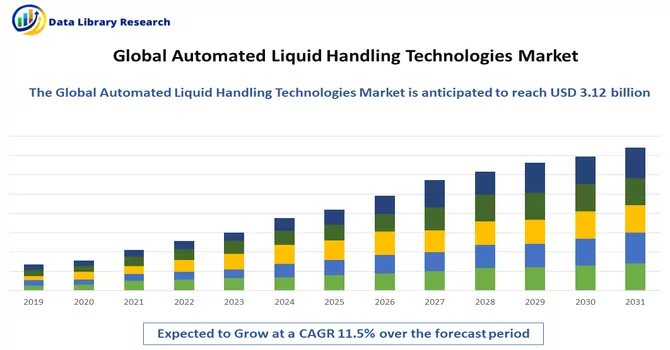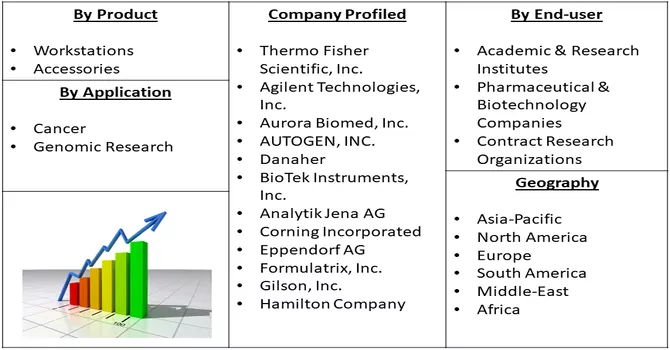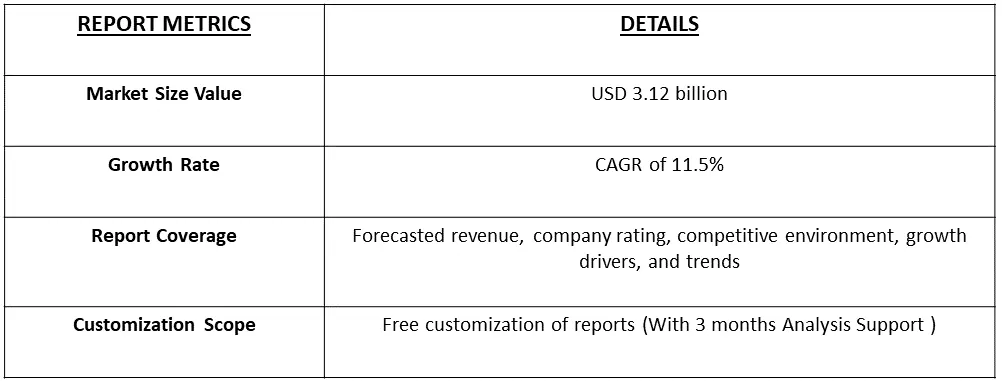The global automated liquid handling technologies market size was estimated at USD 3.12 billion in 2023 and is anticipated to grow at a compound annual growth rate (CAGR) of 11.5% from 2024 to 2031.

Get Complete Analysis Of The Report - Download Free Sample PDF
Automated Liquid Handling Technologies refer to a set of advanced laboratory instruments and systems designed to automate the precise handling and dispensing of liquids in various scientific and research applications. These technologies are utilized to streamline and optimize liquid-based workflows, minimizing manual errors, enhancing efficiency, and increasing throughput in laboratories. Automated Liquid Handling systems are equipped with robotic arms, pipettes, and other components that can perform tasks such as sample dispensing, dilution, mixing, and plate replication with high precision and accuracy. These technologies find widespread application in fields such as genomics, proteomics, drug discovery, clinical diagnostics, and other life science research areas where precise liquid handling is essential. Automated Liquid Handling Technologies contribute to the reproducibility of experiments, reduce the risk of contamination, and improve overall laboratory productivity.
Anticipated growth in the automated liquid-handling sector is fueled by the rising adoption of innovative workstations specifically designed for non-contact dispensing. Traditionally, contact dispensing methods gained popularity owing to their reliability, user-friendly nature, and cost-effectiveness. However, evolving liquid handling needs, particularly in the context of decreasing sample volumes, have prompted the demand for novel solutions. The shift towards non-contact dispensing represents a response to the changing landscape of liquid handling requirements, addressing challenges and offering enhanced precision in dispensing applications. This trend reflects a broader industry acknowledgement of the need for advanced technologies to meet evolving demands and optimize liquid handling processes in various scientific and research applications.
The market for automated liquid handling technologies is experiencing dynamic trends that reflect a paradigm shift in liquid handling practices. A prominent trend is the increased adoption of non-contact dispensing methods, addressing evolving requirements, particularly with diminishing sample volumes. Precision and accuracy enhancements remain a focal point, with continuous efforts to integrate advanced technologies for improved reproducibility. The market is witnessing a surge in the integration of robotics and automation, facilitating high-throughput processing and efficiency. Customization and modularity are gaining traction, providing laboratories with flexible solutions tailored to specific needs. Enhanced software capabilities, diverse applications across industries, and a focus on contamination prevention are shaping the landscape. Next-generation liquid handlers are emerging, setting new standards in performance and versatility. Moreover, there is a growing emphasis on green and sustainable practices, reflecting the industry's commitment to environmentally conscious laboratory operations. These multifaceted trends collectively highlight the industry's dynamic response to the evolving demands of liquid handling processes in scientific and research settings.
Market Segmentation: The automated Liquid Handling Technologies Market is Segmented By Product (Workstations, and Accessories) , Application (Cancer & Genomic Research), End-user (Academic & Research Institutes, Pharmaceutical & Biotechnology Companies and Contract Research Organizations) and geography (North America, Europe, Asia-Pacific, South America, and Africa). The report offers the market size and forecasts in terms of volume in metric tons and value in USD thousand for all the above segments.

For Detailed Market Segmentation - Download Free Sample PDF
Market Drivers:
Increase In Investment In Drug Development, Clinical Trials And Life Science R&D
The surge in investment in drug development, clinical trials, and life science research and development (R&D) is closely intertwined with the advancements in automated liquid handling technologies. As pharmaceutical and biotechnology companies, research institutions, and clinical laboratories intensify their efforts in bringing innovative drugs to market, the demand for efficient and precise liquid handling solutions has seen a significant upswing. Automated liquid handling technologies play a pivotal role in expediting drug discovery processes by offering high-throughput capabilities, reducing manual errors, and enhancing overall efficiency in sample preparation and analysis. The increased investment in R&D is driving the development of next-generation liquid handling systems with advanced features such as robotics integration, modular design, and sophisticated software functionalities. This symbiotic relationship between rising investments in life sciences and the evolving landscape of automated liquid handling technologies underscores their critical role in shaping the future of drug development and biomedical research. For instance, in 2023, The FDA approved 55 novel therapeutics, the second-highest count in the past 30 years. The FDA's Center for Drug Evaluation and Research (CDER) approved 55 new drugs in 2023, as the small molecule and biologic pharmacopoeia continues to grow. Thus, such instances are expected to contribute to the studied segment’s growth.
Rapid Adoption Of Lab Automation
The rapid adoption of lab automation, coupled with the widespread integration of automated liquid handling technologies, signifies a transformative shift in laboratory practices across various scientific disciplines. Laboratories are increasingly embracing automation to enhance efficiency, accuracy, and throughput in sample processing and experimentation. Automated liquid handling technologies play a central role in this paradigm shift by offering precise and reproducible liquid dispensing, reducing manual errors, and enabling high-throughput workflows. The seamless integration of robotic systems with liquid handling platforms further amplifies the pace and efficiency of laboratory processes. This trend is driven by the growing recognition of the need for streamlined and standardized laboratory operations, especially in fields such as genomics, drug discovery, clinical diagnostics, and biotechnology. The combination of lab automation and automated liquid handling technologies not only accelerates research and development efforts but also contributes to the overall advancement of scientific discovery by providing researchers with powerful tools to handle complex tasks with precision and speed.
Market Restraints:
High Cost Of Instruments and Complex Operability Of Advanced Systems
The anticipated growth of the Automated Liquid Handling Technologies market may face challenges attributed to the high cost of instruments and the complex operability of advanced systems. The substantial initial investment required for acquiring and implementing sophisticated liquid handling technologies can be a deterrent, particularly for smaller laboratories and research facilities with limited budgets. The cost factor extends beyond the purchase to maintenance, calibration, and training, contributing to the overall financial burden. Additionally, the complexity of operating advanced systems may pose a barrier to widespread adoption, as it requires specialized expertise and training. Laboratories may encounter challenges in integrating these technologies seamlessly into their existing workflows, potentially slowing down the pace of adoption. Addressing these issues, such as cost-effectiveness and user-friendly operability, will be crucial to ensuring broader accessibility and unlocking the full potential of automated liquid handling technologies across diverse scientific and research domains.
The COVID-19 pandemic underscored the critical need for the safe, accurate, and efficient collection and preparation of virus samples, placing unprecedented demand on laboratories for high-throughput and large-scale testing. In this context, the reliance on automated liquid handling systems has become a standard, particularly in situations where sample preservation and contamination risk reduction are of utmost importance. These systems, exemplified by solutions like PIPETMAX, operate with minimal supervision, ensuring verifiable and repeatable results. PIPETMAX, renowned for its compact footprint, excels in handling large quantities for diverse applications such as cell-based assays and qPCR, establishing itself as an indispensable assistant in the laboratory. Notably, it comes equipped with validated, pre-developed protocols, enhancing overall efficiency in sample processing and analysis.
Segmental Analysis:
Workstations Segment is Expected to Witness Significant Growth Over the Forecast Period
The Workstations and Automated Liquid Handling market is experiencing significant growth, driven by advancements in laboratory automation and the demand for precise, high-throughput liquid handling solutions. Workstations equipped with automated liquid handling technologies play a pivotal role in streamlining laboratory processes, improving efficiency, and ensuring the reproducibility of experiments. These systems find extensive applications in various sectors, including pharmaceuticals, biotechnology, clinical diagnostics, and academic research. The integration of advanced features, such as robotics, modular designs, and user-friendly interfaces, distinguishes modern workstations in this market. Notable introductions, like SPT Labtech's Firefly for LDT and Revvity's Fontus Automated Liquid Handling Workstation, showcase the ongoing innovation in this space. The emphasis on enhancing workflows for next-generation sequencing (NGS) and diagnostic research further underscores the market's responsiveness to evolving scientific needs. As laboratories increasingly seek scalable, efficient, and user-friendly solutions, the Workstations and Automated Liquid Handling market is poised for continued expansion, shaping the future of laboratory automation and liquid handling processes.
Cancer Segment is Expected to Witness Significant Growth Over the Forecast Period
In the realm of cancer research, the utilization of automated liquid handling technologies is significantly advancing our efforts to comprehend the complexities of cancer. Laboratories and research centers focused on cancer studies are increasingly incorporating these automated systems to improve the precision and efficiency of their work. These technologies are instrumental across various facets of cancer research, including the screening of potential therapeutic compounds, genomic and proteomic analyses, and the preparation of samples for diagnostic tests. The capability of automated systems to handle multiple samples concurrently, while minimizing errors and contamination risks, proves particularly advantageous in the expansive landscape of cancer research, where large-scale studies are commonplace. The market for Automated Liquid Handling in cancer research is witnessing a surge in innovative solutions tailored to the specific requirements of oncology laboratories. These advancements contribute to accelerating the pace of cancer-related discoveries, ultimately propelling advancements in personalized medicine and treatment strategies. As the demand for more efficient and scalable solutions in cancer research grows, the Automated Liquid Handling Market continues to play a pivotal role in driving progress in the ongoing fight against cancer.
Pharmaceutical & Biotechnology Companies Segment is Expected to Witness Significant Growth Over the Forecast Period
The adoption of automated liquid handling technologies by pharmaceutical and biotechnology companies represents a transformative shift in laboratory practices within these industries. These advanced systems play a crucial role in optimizing various aspects of drug discovery, development, and biotechnological research. Automated liquid handlers facilitate high-throughput screening of compounds, precise dispensing of reagents, and the preparation of complex assays, significantly accelerating the drug development process. The pharmaceutical and biotechnology sectors benefit from the scalability and reproducibility offered by these technologies, ensuring consistent and reliable results in large-scale experiments. The integration of robotics, modular designs, and sophisticated software in automated liquid handling systems enhances operational efficiency and streamlines complex workflows. As these industries continue to push the boundaries of scientific innovation, automated liquid handling technologies serve as indispensable tools, contributing to increased efficiency, reduced manual errors, and ultimately accelerating the pace of groundbreaking discoveries and advancements in drug development and biotechnology research.
North America Region is Expected to Witness Significant Growth Over the Forecast Period
In North America, the integration of liquid handling technologies has become indispensable for advancing research and laboratory processes across diverse industries. Positioned at the forefront of technological innovation, the region witnesses widespread adoption of automated liquid handling solutions by laboratories, pharmaceutical companies, biotech firms, and academic institutions to elevate efficiency and precision. The growing demand for high-throughput systems in genomics, drug discovery, clinical diagnostics, and various scientific disciplines propels the expansion of the liquid handling technologies market in North America. The region's commitment to cutting-edge research and development aligns seamlessly with the capabilities offered by these technologies, encompassing robotics integration, modular designs, and advanced software functionalities. As North American laboratories aim for scalable and efficient solutions, liquid handling technologies play a pivotal role in shaping the scientific landscape, and driving advancements in healthcare, biotechnology, and life sciences. Recent developments in the region, such as SPT Labtech's introduction of the apricot DC1 and Festo's modular gantry robot platform for automated liquid handling systems, are poised to further stimulate the growth of this evolving market.

Get Complete Analysis Of The Report - Download Free Sample PDF
Key Automated Liquid Handling Technologies Companies:
Recent Development:
1) In November 2023, SPT Labtech launched Firefly for LDT, a solution tailored to streamline liquid handling in the context of Next-Generation Sequencing (NGS)-based lab-developed tests (LDTs).
2) In July 2023, Revvity introduced the Fontus Automated Liquid Handling Workstation. This cutting-edge liquid handler integrates advanced technologies from Revvity's existing platforms and is specifically engineered to optimize and accelerate workflows for next-generation sequencing (NGS) and diagnostic research applications.
Q1. What was the Automated Liquid Handling Technologies Market size in 2023?
As per Data Library Research the global automated liquid handling technologies market size was estimated at USD 3.12 billion in 2023.
Q2. What is the Growth Rate of the Automated Liquid Handling Technologies Market?
Automated Liquid Handling Technologies Market is anticipated to grow at a compound annual growth rate (CAGR) of 11.5% over the forecast period.
Q3. What segments are covered in the Automated Liquid Handling Technologies Market Report?
By Product, Application, End User and Geography these segments are covered in the Automated Liquid Handling Technologies Market Report
Q4. Which Region is expected to hold the highest Market share?
North America region is expected to hold the highest Market share.
Data Library Research are conducted by industry experts who offer insight on industry structure, market segmentations technology assessment and competitive landscape (CL), and penetration, as well as on emerging trends. Their analysis is based on primary interviews (~ 80%) and secondary research (~ 20%) as well as years of professional expertise in their respective industries. Adding to this, by analysing historical trends and current market positions, our analysts predict where the market will be headed for the next five years. Furthermore, the varying trends of segment & categories geographically presented are also studied and the estimated based on the primary & secondary research.
In this particular report from the supply side Data Library Research has conducted primary surveys (interviews) with the key level executives (VP, CEO’s, Marketing Director, Business Development Manager and SOFT) of the companies that active & prominent as well as the midsized organization
FIGURE 1: DLR RESEARH PROCESS

Extensive primary research was conducted to gain a deeper insight of the market and industry performance. The analysis is based on both primary and secondary research as well as years of professional expertise in the respective industries.
In addition to analysing current and historical trends, our analysts predict where the market is headed over the next five years.
It varies by segment for these categories geographically presented in the list of market tables. Speaking about this particular report we have conducted primary surveys (interviews) with the key level executives (VP, CEO’s, Marketing Director, Business Development Manager and many more) of the major players active in the market.
Secondary ResearchSecondary research was mainly used to collect and identify information useful for the extensive, technical, market-oriented, and Friend’s study of the Global Extra Neutral Alcohol. It was also used to obtain key information about major players, market classification and segmentation according to the industry trends, geographical markets, and developments related to the market and technology perspectives. For this study, analysts have gathered information from various credible sources, such as annual reports, sec filings, journals, white papers, SOFT presentations, and company web sites.
Market Size EstimationBoth, top-down and bottom-up approaches were used to estimate and validate the size of the Global market and to estimate the size of various other dependent submarkets in the overall Extra Neutral Alcohol. The key players in the market were identified through secondary research and their market contributions in the respective geographies were determined through primary and secondary research.
Forecast Model
